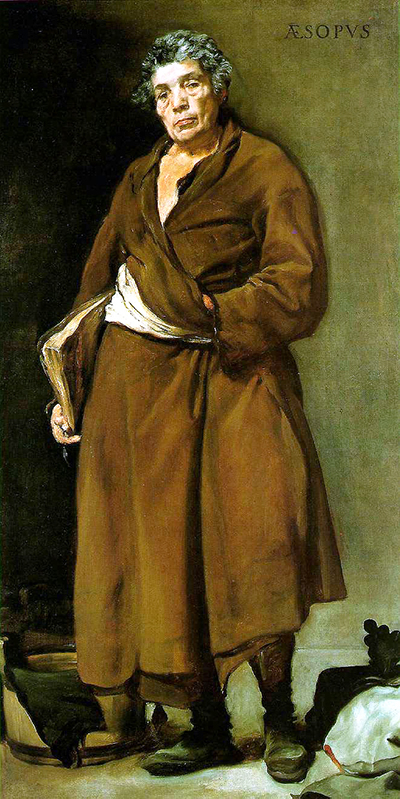Diego Velazquez completed this full length portrait in 1638 and it features an elderly figure with a worn face that perfectly suits the artistic style of this famous Spanish painter.
This painting was discovered alongside a number of Rubens paintings at the Torre de la Parada around half a century after it was completed. It is believed that this artwork was linked to a number of other Velazquez artworks which were connected through the subjects used. The figures of Aesop and Menippus are both philosophers from the past, and Rubens himself would also produce his own versions of them. This brings together an interesting comparison where we can judge how these two artists handle the same content, and Velazquez's versions place the men in much poorer clothing, almost akin to those of beggars. He wanted to reduce them to normal people just as far as he could, to play on their humanity, where as Rubens lifted them with more positive and glamorous appearances.
Aesop wears a fairly loose brown coat with a white cloth wrapped around the waist. A book can be found in the right hand, suggesting the role of this individual as was often done during this period of western art. The hair is grey and the face aged, which allows light to attack the contours of the face. The boots appear hardy, certainly not for show and the whole image feels distinctly tough and real, akin to some of the honest portrayals of peasant life by the likes of Gustave Courbet, with The Stone Breakers and After Dinner at Ornans. It is refreshing to see an artist being brutally honest and real at a time when most would portray everyone in as good a light as they possibly could.
Aesop can be found in the permanent collection of the Museo del Prado in Madrid, Spain. Artist Velazquez is particularly well served in this venue, and around sixty paintings from his career can be found here, alongside other major paintings and sculptures from European history, roughly covering the period from the Northern and Italian Renaissance up to around the 19th century. Their selection of Sorolla paintings, for example, is some of the most recent artworks to be found here. It remains one of the most important places for followers of Spanish art and is an excellent opportunity for tourists to get to see such a wealth of quality under one roof. Those with broader tastes can also find more recent artworks in a number of art galleries which are situated within walking distance of the Prado, although it would take a lot of energy to fit in more than one of these venues in the same day.




